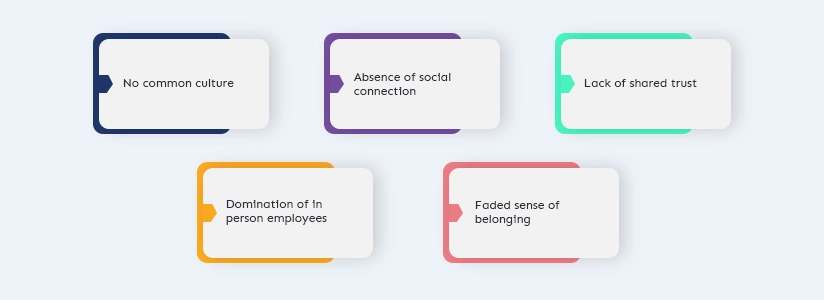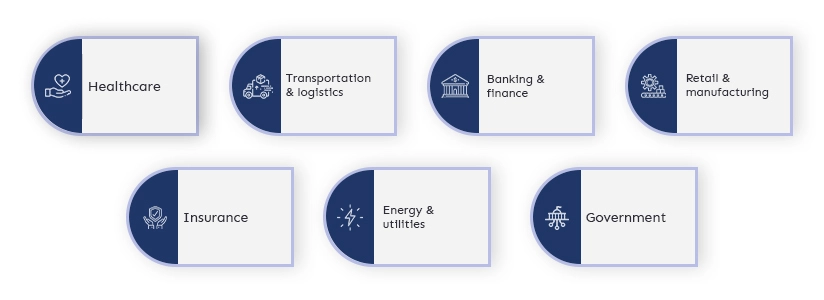Hybrid Working Model: A New Normal For Businesses After The Pandemic

It’s over a year since the vaccinations were hurling in, being tested for the new mutations of coronavirus, and everyone was asked to stay home. Now the world has moved past the pandemic and brought enterprise executives’ attention to a new problem – getting employees back to the office.
While working from home was not a new idea, after being home-bound for more than two years, employees do not expect to return to the workplace the way it was.
As per one McKinsey survey of 100 executives across global businesses, the top leaders think that 9 out of 10 organizations will be opting for the hybrid working model. The survey further points out that only 10% of the employees expect to work full time from the office after the pandemic.
Employees working from home have been beneficial for enterprises as well. Due to the flexibility of working from home, the productivity and quality of work have improved. It is also true that the comfort of home and absence of office distractions polished the performance of employees.
But is this the future work structure for all big and small companies? And another important issue to focus on is whether it is sustainable in the long run? How does it affect employees’ creative competence, critical thinking, and work ethic?
We will look into more such insights later; first, let’s discuss what a hybrid working model is.
Hybrid Working – A New Working Structure Post-Pandemic
Covid 19 forced employees to work from home, and their return to the workplace has created another opportunity. In such increasingly changing times, companies and top management must address the widening disconnect of employees with the workplace.
That is why the HR department and top executives are thinking of introducing the hybrid working model.
A hybrid or virtual model combines remote and onsite working where some employees work from home while others are on-premises. This new working model is expected to increase productivity, reduce costs, foster flexibility and improve team performance.
Many companies and startups have announced the adaptation of hybrid working. Here is a list of all such corporations. While hybrid working sounds promising and full of potential, history shows otherwise. In 2013, Yahoo CEO Marissa Mayer called off the hybrid working experiment quoting that Yahoo needs to become one again.
This is because, in the beginning, hybrid or remote working seems like companies have found the perfect formula for employee satisfaction at a reduced cost. But it isn’t easy to implement a hybrid working model across businesses. Mixing virtual employees with onsite staff is harder than it sounds. There are many downsides of remote working at scale, which overcome the positives. Let’s discuss them in detail.
The problem with hybrid or virtual working
Some employees are working from home, and others are the in-house staff; that’s hybrid working—the flexibility to work from anywhere is the underlying cause of the concern for employing hybrid teams.
The way of working from home and in the office has very different organizational norms, which affect the performance and culture. Also, the behavior changes generated over time due to less in-person interaction lead to a lack of cohesion and trust. In the long run, remote working and in-house teams lose the connection due to virtual collaboration, which was there in the beginning.
Such cultural and trust issues might foster and divide the team into in-person workers and WFH employees. And as the apple doesn’t fall far from the tree, the in-person workers and managers will have better collaboration, cohesion, and trust, eventually implying dominance over the far from office employees. The WFH force might even feel left out, disconnected and unhappy.
The lack of a functional hybrid working model leads to a loss of common purpose, identity, and belonging. This ultimately deteriorates the team performance as well.
Misaligned hybrid and on-premise system results into:

What does this mean for your enterprise?
The world has moved to the post-pandemic era, and now it’s time to reimagine your staff situation. You can choose the hybrid model or go full-time in-house like pre-covid time. The key is to figure out your decision’s short-term and long-term effects on organizational culture.
You need to structure the hybrid working model that fits your company culture and promotes social connection, shared identity, and a sense of belonging among the employees.
While a hybrid model seems like a perfect solution, it is also important to remember that not all employees are willing to come back to the office. Also, with the virtual working model, you will still need office space. Because with partially remote work, physical spaces are still required.
So, what should you choose now? Does the hybrid working model sound like a compelling idea for your company?
A hybrid working model can be a great initiative, but it will require employees to attend the office 3 – 4 days a week and work from home the rest of the time. Even if half of your employee strength is working on-premises for four days a week, you need an office space full time.
A better alternative than hiring a team from multiple locations worldwide is to outsource your business tech requirements. Outsourcing is a well-established industry that has delivered phenomenal results for enterprises of all sizes – multinational corporations, SMBs, and startups alike.
Both the public and private sectors have adopted the outsourcing business strategy to mitigate risks, tap into the resource pool, save costs and improve performances. In other words, choosing an software consulting company as an external service provider can help your business with all the tech issues. From migrating a website to developing full-fledged management systems, your outsourcing partner can do it all while you focus on what you do best.
Hiring Offshore Company – A Collaborative and Futuristic Approach
It is a common stereotype among business owners that outsourcing is aimed only at cost-saving with no attention to product quality. Also, outsourcing is the small business solution that can’t afford a tech team – A prevailing misconception that is not true. Here are some stats to debunk all such negative ideologies on software outsourcing.
- A global outsourcing market study for 2020 – 2024 by report linker states that the industry will grow by $98 billion by 2024 at a 5% CAGR.
- A datamark study found that companies saved over 33% in three years via outsourcing.
- Deloitte says that 70% of businesses looked for an outsourcing partner in 2020.
- Also, this outsource accelerator article states that outsourcing can cut labor costs upto 70%.
- It is not just the labor costs that propelled businesses to turn to outsourcing. Statistics show that 49% of companies outsource to free up resources and focus on their core competencies.
Heavy reliance on cloud technologies
Cloud technologies are another reason for the rapid expansion of outsourcing IT services. The ease of access to company documents, project reports, and all other data has made software outsourcing a reliable practice for the top management of large corporations and small businesses.
- This 2019 Nutanix cloud study concludes that 93% of businesses outsourcing their services have integrated cloud technologies.
- Along with this, it is also predicted by Gartner in its press release that the cloud market value will grow upto $331 billion in 2022.
Looking at these stats, it is clear that the future of cloud technology is shining already. And IT outsourcing mixed with the cloud is the tempting cocktail for outsourcing services success, both for clients and the custom software development company.
Infact, more than 44% of CEOs agree that they’re more likely to go for outsourcing services than they were five years ago.
Small businesses are outsourcing
You might be thinking that outsourcing is only for MNCs and global businesses. But small and medium-sized businesses are equally choosing outsourcing services to grow their business.
Small businesses have gained a lot of technological edge because of outsourcing. A 2021 survey by Clutch on small businesses revealed that 80% of small businesses outsourced to access talent and resources.
The same study also found that 23% of small businesses will outsource finance operations while 21% are looking to outsource legal services. Less than 20% will outsource digital marketing, development, and HR operations.
The prime advantage of outsourcing for small businesses is it allows them to focus on core abilities while delegating tech and other departments to third-party experts.
Outsourcing by different Industries
As per a February 2022 report by Statista, the global market size of outsourced services is 92.5 billion USD. This number is bound to increase as client satisfaction, and business efficiency have increased with outsourcing services.
All the major industry sectors plan to outsource their services for better talent access, expert outlooks, and reduced labor costs. Here are the top industries which outsource their services to third-party vendors.

Benefits of outsourcing
As discussed in the previous section, cost-saving is not the only motivation for outsourcing. After 25 years, the outsourcing industry is much more established and secure. Many countries have established laws for safe business practices with companies globally.
It has grown into a multi-billion dollar industry, and it won’t be wrong to predict that the outsourcing industry will keep on thriving. Covid has made the commercial and corporate world realize the power of the internet and its varied uses. From making appointments with doctors on your mobile to managing the transportation and distribution of billions of vaccines worldwide, tech has helped us achieve it all.
Here is an infographic to give you a complete perspective on the different ways outsourcing is rewarding for your business.

Let’s wrap up
Initially focused on back-office and BPO services, outsourcing now includes product building strategies, and major business decisions, with some enterprises handing over their entire departments to the offshore partner.
The flexibility, cost-effectiveness, and productivity-boosting benefits of outsourcing promise more success for the industry. It will spread throughout the industries and all the different sectors exponentially.
Don’t be left behind. Catch up on the promising business model of outsourcing for your software requirements. Our offshore software development company is an appreciated partner to many top brands worldwide. Contact our team for any queries or quotes. We are always eager to help businesses develop the best strategies for growth and financial benefits.
Similar Posts

Why PHP Laravel Framework is the Best
Picking a PHP development framework for developing web applications with can be a daunting and challenging task considering that there are currently so many options to consider. Nevertheless, some frameworks have proven themselves to be reliable when it comes to web development. One such framework is Laravel. In this article, we will be looking at […]...

How Smart Contracts are Revolutionizing the Real Estate Sector
Are you tired of the cumbersome processes, excessive paperwork, and exorbitant costs associated with real estate transactions? Have you ever wondered if there’s a better way to buy or sell property in today’s digital age? Well, you’re not alone. In fact, according to recent studies, the real estate industry is plagued by inefficiencies, with an […]...

Top 10 Software Development Methodologies to Choose from
When creating software, how you approach the project affects the output significantly. Ideally, you have to strike a balance between speed and structure, rigidity and flexibility. The software needs to be market-ready with the least deviation possible. You also have to minimise risk, reduce the chances of errors, and meet the deadlines without ever compromising […]...






